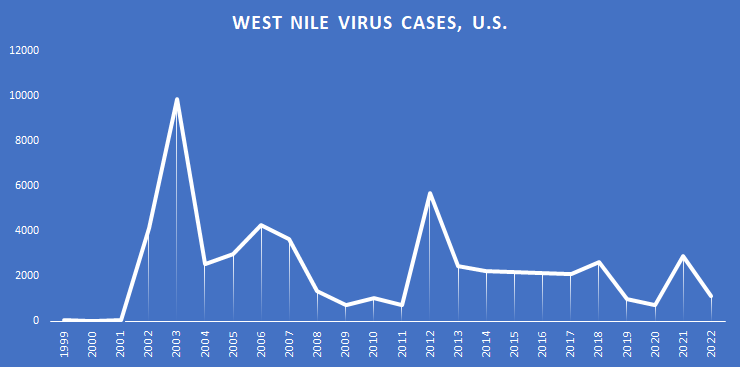Recently, there’s been more attention on WNV with reports in Missouri, Wisconsin and other places, and the hospitalization of Anthony Fauci. You hear a lot about this being a mosquito vector (spread) disease, and it is, but birds play a role.
The presence of West Nile Virus in the United States is a new one, as infectious diseases go. The first cases arrived in 1999. The New York City metropolitan area was the first to witness the arrival of this disease, which was previously considered tropical in nature. It was thought that perhaps shipping containers had spread the disease. By 2001, WNV had reached Bergen County, NJ, where an elderly woman was hospitalized complaining of fever and muscle weakness.
“Two decades ago, the first cases of this tropical disease to hit New York shocked. Now, West Nile is no stranger to the USA. It may strike in Montana. It may strike in the Bronx.”
As there had been a few cases in Staten Island, tests for West Nile were run, and the surprising disease was confirmed. In that year, New Jersey towns began spraying pesticides not only near the infected patients’ homes and in any large bodies of standing water under county or municipal control.
It was the beginning of a wake-up call on the globalization of disease. By 2003, West Nile Virus, or WNV, was endemic in North America. It had reached the Midwest and Rocky Mountains and could be classified as an epidemic. Today, it’s possible to get West Nile in Carbon County, MT or Bronx, NY; Los Angeles County, CA, or Cherokee County, GA. In 2023, there were a total of 2,406 reported cases of West Nile virus disease in the United States.
The chart accompanying this article shows cases in the US. While the spike of twenty-one years ago has not been repeated, owing in part to consistent vigilance by public health authorities and mosquito control agencies, cases are a regular feature.
Yet West Nile is not new to the world. It was first detected in Uganda in the 1930s, and since then, human cases have been routinely reported. The disease is more commonly found in Africa and the Middle East. It has the capability to induce a fatal neurological illness known as encephalitis. It is noteworthy that the severe stage of the disease occurs in approximately 1 in 150 cases, with an elevated risk for older individuals and those with compromised immune systems.
WNV is primarily transmitted through vectors, in this case, mosquitoes and particularly Culex tarsalis and Cx. quinquefasciatus mosquitoes. Birds also play a role in extending the transmission cycle. To combat the virus effectively, health authorities and governments focus on mosquito prevention. Mosquitoes are attracted to human skin odors and exhaled carbon dioxide, making repellents and long-sleeved clothing essential for avoiding the disease.
In 2008, the University of South Dakota conducted a study that revealed a correlation between mosquito abundance and disease incidence. (https://journals.plos.org/plosone/article?id=10.1371/journal.pone.0003744) The results were not surprising; more mosquitoes meant a greater likelihood of disease: “Based on our analysis of the 2003 WNV epidemic in the northern Great Plains, we found multiple lines of evidence to support the hypothesis that the geographic distribution of Culex tarsalis is at least partially responsible for the continued high levels of WNV incidence in this region.”
“Changes in temperature not only mean more mosquitoes but also fewer mosquito predators. And faster development of the virus in mosquitoes.”
What is interesting about this study (which cited similar studies) is that it’s not just about climate getting warmer and thus more mosquitoes. It’s also not just about more rain leading to more mosquitoes, though that is a factor. It’s about climate becoming more variable. The variability of that temperature not only means more mosquitoes but also fewer mosquito predators. And something else. Faster development of the virus in mosquitoes. “results in more rapid maturation of mosquitoes and decreases the extrinsic incubation period of the virus.”
Temperature variability across spaces and times is a growth factor for WNV cases. Simply said, this suggests climate change and globalization are factors in the spread.
In response to this evolving threat, new strategies have been explored. One of them involves the introduction of larvae-eating fish into water bodies suspected of mosquito breeding. Unfortunately, there is no vaccine or specific treatment for WNV, with rest and over-the-counter pain medication being the main approach, and in severe cases, intravenous fluids and other medications may be administered to patients. This emphasizes the critical role of diagnostics, particularly immunoassays, in identifying WNV cases. Laboratory diagnosis typically involves testing serum or cerebrospinal fluid (CSF) to detect WNV-specific IgM antibodies. However, these antibodies may persist for an extended period, leading to some challenges in diagnosis. Therefore, additional confirmatory tests may be necessary.
This is not a disease where molecular testing is coming to the rescue. PCR tests can be performed but it can miss some infections, because viral material may be absent in the body by the time symptoms appear. There is a little debate about what that period of effectiveness is. 8 days from infection seems to be standard. Which may not be enough for effective practice. However, PCR of cerebral spinal fluid is often utilized in a case where there is suspected neurological infection. Immunohistochemistry (IHC) can also identify WNV antigen in formalin-fixed tissue, but negative results do not rule out WNV infection. Thus IgM tests remain standard.
In terms of branded diagnostics, there are various tests available, including the Roche cobas® TaqScreen West Nile Virus Test, Response Biomedical RAMP, Altona Diagnostics RealStar® WNV RT-PCR Kit 2.0, CTK Biotech RT PCR Test, Eurofins Viracor West Nile Test, and Aridia West Nile Virus Real-Time PCR Test, among many others.
West Nile is one of several emerging diseases which drive the infectious disease market. It’s not the only one – there are even other vector diseases, dengue, malaria that see increasing cases in the United States.
What is the size of the market for WNV? Eye on IVD is assembling an Infectious Disease Market report to monitor these developments and provide useful market assessments for infectious disease areas.


